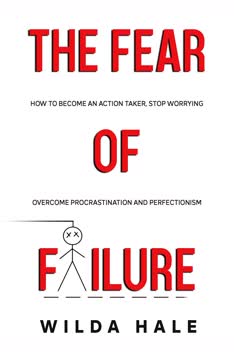Key Takeaways
1. Fear is a survival mechanism, but the fear of failure can be debilitating.
Most often, fear holds us back more than any obstacle would.
Understanding Fear. Fear is a fundamental survival mechanism, designed to alert us to threats. It triggers a biochemical response, preparing us to fight or flee. However, the fear of failure can become debilitating, leading to avoidance and missed opportunities. This fear often stems from deeper core fears, such as extinction, mutilation, loss of autonomy, separation, and ego death.
Childhood Influences. Early experiences, particularly those involving parents and peers, significantly shape our perception of failure. Overprotective or overly critical parenting can instill a fear of failure that persists into adulthood. It's crucial to recognize these influences and begin to dismantle their long-lasting impact.
Moving Beyond Programming. The brain has immense storage capacity and malleability. By becoming aware of our thoughts and their origins, we can begin to reprogram our minds. Recognizing that fear is a learned response, not an immutable truth, is the first step toward overcoming it.
2. Reframe failure as a learning opportunity, not a final judgment.
There is no doubt in my mind that there are many ways to be a winner, but there is really one way to be a loser, and that is to fail and not look beyond failure.
Perspective is Key. Our perspective on failure significantly impacts our ability to learn and grow. Viewing failure as a catastrophe leads to self-sabotage, while seeing it as feedback allows for adaptation and improvement. Success and failure are not mutually exclusive; they are intertwined aspects of the same journey.
The Iceberg of Success. What we see as success is merely the tip of the iceberg. Beneath the surface lies a vast foundation of mistakes, dedication, failure, persistence, and disappointment. Embracing this reality allows us to view setbacks as necessary steps toward achievement.
Cultivating a Growth Mindset. Carol Dweck's research highlights the importance of a growth mindset, which emphasizes the belief that abilities can be developed through dedication and hard work. This mindset fosters resilience, encourages experimentation, and transforms obstacles into opportunities for learning.
3. Overthinking leads to paralysis; action overcomes fear.
The mind is a wonderful servant but a terrible master.
The Trap of Rumination. Overthinking, or rumination, involves obsessively dwelling on problems, mistakes, and negative thoughts. This can lead to stress, anxiety, and analysis paralysis, hindering our ability to take action. It's essential to distinguish between functional problem-solving and destructive rumination.
Breaking the Cycle. Several strategies can help stop rumination, including taking action, challenging negative thoughts, refocusing attention, slowing down thoughts, focusing on micro-solutions, setting time limits for worry, practicing acceptance, and taking cold showers. These techniques help to disrupt the cycle of negative thinking and promote a more proactive approach.
Cognitive Restructuring. Cognitive distortions, or negative self-talk, often fuel overthinking. By challenging these distortions and reframing our thoughts, we can reduce their believability and regain control over our mental state. This process involves questioning the accuracy of negative thoughts and replacing them with more balanced and realistic perspectives.
4. Perfectionism hinders progress; embrace imperfection.
And now that you don’t have to be perfect, you can be good.
The Perils of Perfectionism. While a healthy drive for excellence can be motivating, maladaptive perfectionism leads to unrealistic expectations, procrastination, and self-criticism. This can result in stress, anxiety, and a diminished appreciation for accomplishments. It's crucial to distinguish between striving for excellence and demanding flawlessness.
Generational Trends. Studies show that perfectionism is on the rise, particularly among younger generations, potentially fueled by social media and increasing societal pressures. This trend is accompanied by a rise in mental health issues, highlighting the detrimental effects of striving for an unattainable ideal.
Self-Compassion as an Antidote. Self-compassion, which involves treating ourselves with kindness and understanding, can buffer against the negative effects of perfectionism. This includes accepting our flaws, recognizing our shared humanity, and practicing mindfulness.
5. Courage, supportive relationships, and self-discipline are essential for achievement.
Courage doesn’t always roar. Sometimes courage is the quiet voice at the end of the day saying: I will try again tomorrow.
The Power of Courage. Courage, or boldness, is a better predictor of success than intelligence. It enables us to take risks, ask for what we want, and persevere in the face of setbacks. Overcoming self-doubt and self-rejection is crucial for achieving our goals.
The Influence of Relationships. The people we surround ourselves with significantly impact our lives and our level of success. Surrounding ourselves with supportive, positive individuals who inspire us to grow is essential for thriving.
The Role of Self-Discipline. Self-discipline, more than innate intelligence, is correlated with success. It involves consistent effort, sustained work, and the willingness to sacrifice short-term gratification for long-term goals. Cultivating self-discipline is key to overcoming procrastination and achieving our full potential.
6. Confront worry and your inner critic with practical strategies.
I am an old man and have known a great many troubles, but most of them never happened.
Taming Worry. Worry keeps the mind in a state of blur, making us helpless in the face of problems. To conquer your fears, you'll have to define them first! A five-step technique can help to clarify the situation and reduce anxiety. This involves defining the problem, assessing potential consequences, identifying actions to mitigate those consequences, accepting what cannot be changed, and focusing on potential positive outcomes.
Silencing the Inner Critic. The harshest critic we will ever have will be the one inside our head. That inner voice that keeps nagging us, always whispering about our shortcomings, acts like our biggest bully. It's awfully mean for someone who doesn't really provide us with much. Detaching from your inner voice and reframing negative self-talk can help to reduce its impact.
Practicing Self-Kindness. Treating yourself with kindness and compassion is essential for mental well-being. This involves accepting your flaws, recognizing your shared humanity, and responding to yourself with the same care and understanding you would offer a friend.
7. Prioritize stress management and self-care for a balanced life.
You must learn in life to take things more lightly, my dear. ...
The Importance of Balance. Life is meant to be enjoyed, and this section is all about finding inner balance. There are so many incredible things around us, but they often get overlooked because we get too stuck in our heads. Stress management techniques improve our mental wellbeing, making us feel relaxed and happy from the inside. They should be a consistent practice in our lives, just like brushing our teeth or washing our hair.
Mindfulness Practices. Mindfulness teaches us stillness, to enjoy the present moment. It is a mental state we achieve when we focus on being in the moment while calmly acknowledging and accepting our thoughts, feelings, and bodily sensations. Simple activities like walking through the woods, gardening, washing the dishes, or playing an instrument can be acts of mindfulness.
Additional Techniques. Other effective stress management techniques include setting a daily intention, practicing breathing exercises, spending time in nature, and cultivating gratitude. These practices help to promote relaxation, reduce anxiety, and enhance overall well-being.
Last updated:
FAQ
1. What’s "The Fear of Failure" by Wilda Hale about?
- Overcoming Fear and Inaction: The book explores how fear of failure holds people back from taking action, achieving goals, and living fulfilling lives.
- Practical Strategies: Wilda Hale provides actionable advice to help readers become action takers, stop worrying, and overcome procrastination and perfectionism.
- Psychological Insights: The book delves into the origins of fear, the impact of childhood experiences, and the role of mindset in personal growth.
- Tools for Change: Readers are guided through techniques to manage their inner critic, reframe failure, and build resilience, with the aim of living life on their own terms.
2. Why should I read "The Fear of Failure" by Wilda Hale?
- Universal Struggle: The fear of failure is a common obstacle that affects people in all areas of life, from careers to relationships.
- Actionable Advice: The book offers step-by-step methods and real-life examples to help readers break free from self-doubt and inaction.
- Mindset Transformation: It teaches how to shift from a fixed to a growth mindset, making setbacks less intimidating and more productive.
- Holistic Approach: The book addresses not just fear, but also related issues like perfectionism, procrastination, and stress, providing a comprehensive toolkit for self-improvement.
3. What are the key takeaways from "The Fear of Failure" by Wilda Hale?
- Fear is Normal, Not Fatal: Fear serves as a survival mechanism, but when it becomes paralyzing, it must be addressed.
- Mindset Matters Most: Adopting a growth mindset and reframing failure as feedback are crucial for progress.
- Action Over Perfection: Taking imperfect action is more valuable than waiting for the perfect moment or outcome.
- Practical Tools: Techniques like the "3,2,1, Go!" method, dopamine detox, and self-compassion are highlighted as effective ways to overcome procrastination and self-criticism.
4. How does Wilda Hale define and explain the fear of failure in "The Fear of Failure"?
- Survival Mechanism: Fear is described as a natural response designed to protect us from threats, but it can become maladaptive.
- Core Fears: The book references Dr. Karl Albrecht’s five core fears—extinction, mutilation, loss of autonomy, separation, and ego death—as underlying sources of the fear of failure.
- Childhood Roots: Early experiences with overprotective or critical caregivers can program individuals to avoid failure and view mistakes negatively.
- Emotional and Biochemical Responses: Fear triggers both universal physical reactions (fight or flight) and individualized emotional responses, influencing behavior and decision-making.
5. What practical strategies does "The Fear of Failure" by Wilda Hale offer to overcome procrastination and perfectionism?
- Break Tasks Down: Use detailed to-do lists and break large tasks into small, manageable steps to reduce overwhelm.
- Embrace Imperfection: Adopt the mindset of "just do it badly" to bypass the paralysis of perfectionism and start taking action.
- Time Management Tools: Apply the Pomodoro technique, set strict deadlines, and use Parkinson’s Law to increase productivity.
- Action Before Motivation: Start with small actions to build momentum, as motivation often follows action rather than precedes it.
6. How does "The Fear of Failure" by Wilda Hale address the role of mindset in overcoming fear and achieving success?
- Growth vs. Fixed Mindset: Drawing on Carol Dweck’s research, the book contrasts the growth mindset (embracing challenges, learning from setbacks) with the fixed mindset (avoiding risks, seeing failure as final).
- Mindset is Malleable: Anyone can develop a growth mindset through continuous learning, perseverance, openness to feedback, and celebrating others’ successes.
- Reframing Failure: The book encourages viewing failure as feedback and a necessary part of the journey toward achievement.
- Visualization and Self-Talk: Techniques like reframing fear as excitement and visualizing positive outcomes help shift mindset from threat to opportunity.
7. What are the "3 secret ingredients for achievement" according to Wilda Hale in "The Fear of Failure"?
- Courage: Taking risks, facing rejection, and acting despite self-doubt are emphasized as more important than intelligence for success.
- The People Around You: Surrounding yourself with positive, growth-oriented individuals and communities is crucial for personal development.
- Self-Discipline: Consistency, delayed gratification, and managing dopamine-driven distractions are key to long-term achievement.
8. How does "The Fear of Failure" by Wilda Hale suggest dealing with overthinking and the inner critic?
- Recognize Rumination: Understand the difference between helpful problem-solving and destructive overthinking.
- Cognitive Techniques: Use cognitive restructuring to challenge negative thoughts and reframe them more realistically.
- Detachment Exercises: Visualize the inner critic as a separate entity (e.g., placing it in your palm or singing its words) to reduce its power.
- Self-Compassion: Practice speaking to yourself with kindness, as you would to a friend, to counteract harsh self-judgment.
9. What is the "dopamine detox" method in "The Fear of Failure" by Wilda Hale, and how does it help with motivation?
- Understanding Dopamine: The book explains how high-dopamine activities (social media, junk food, TV) make less stimulating tasks seem boring.
- Dopamine Detox Practice: Designate one or more days per week to abstain from high-dopamine activities, allowing your brain to reset.
- Increased Motivation: After detoxing, tasks that previously felt tedious become more appealing, making it easier to focus and be productive.
- Use Rewards Wisely: Reserve enjoyable activities as incentives for completing important, less stimulating tasks.
10. What are the main stress management and self-care techniques recommended in "The Fear of Failure" by Wilda Hale?
- Mindfulness: Engage in present-moment awareness through activities like the five senses exercise, focus objects, and body scans.
- Daily Intention: Set a guiding intention each morning to shape your mindset and actions for the day.
- Breathing Exercises: Practice belly breathing, 3-6-9 breathing, and color breathing to reduce anxiety and tension.
- Nature and Gratitude: Spend time outdoors and keep a gratitude journal to boost mood and resilience.
11. What are the most important quotes from "The Fear of Failure" by Wilda Hale, and what do they mean?
- "The only thing we have to fear is fear itself." (FDR): Highlights that fear is often the biggest obstacle, not the actual challenges.
- "It is impossible to live without failing at something unless you live so cautiously that you might as well not have lived at all, in which case you have failed by default." (J.K. Rowling): Emphasizes that avoiding risk is its own form of failure.
- "Action leads to motivation, not the other way around." (Book’s core message): Encourages readers to start with small actions to build momentum.
- "Easy choices, hard life. Hard choices, easy life." (Jerzy Gregorek): Reminds readers that short-term comfort leads to long-term dissatisfaction, while embracing challenges leads to fulfillment.
12. How can readers best apply the advice from "The Fear of Failure" by Wilda Hale to their own lives?
- Start Small and Practice: Implement one technique or mindset shift at a time, rather than trying to overhaul everything at once.
- Track Progress: Regularly review your growth, mistakes, and improvements to stay motivated and accountable.
- Revisit and Reflect: Return to the book’s chapters as needed, since forming new habits and overcoming fear is an ongoing process.
- Celebrate Imperfect Progress: Focus on consistent action and self-compassion, understanding that setbacks are part of the journey toward lasting change.
Review Summary
The Fear of Failure by Wilda Hale receives mostly positive reviews, with an average rating of 4.09 out of 5. Readers appreciate its practical advice on overcoming fear, procrastination, and perfectionism. Many find it inspiring and motivational, praising the author's writing style and relatable content. Some readers report implementing the strategies in their daily lives with success. However, a few critics find the book simplistic or repetitive, suggesting it could have been more concise. Overall, most readers recommend it as a helpful resource for personal growth and overcoming fear of failure.
Similar Books







Download PDF
Download EPUB
.epub digital book format is ideal for reading ebooks on phones, tablets, and e-readers.





